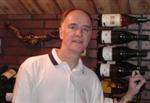 |
Fred
Brack Raleigh, NC |
|
 |
Fred
Brack Raleigh, NC |
|
Our 25th Anniversary Trip to Australia
and Fiji
September/October 1999
Continued
Then it was off to Townsville, to finally see James Cook University, where Michelle has been studying since August. The weather was quite different from Sydney and Adelaide -- hot and humid. The trees were different, too -- definitely a tropical feel to the JCU campus, which is a far cry from Wake Forest University, Michelle's home school! We took Michelle and Tom, her boyfriend, to dinner in town at a waterfront restaurant. Townsville seemed very nice. It is one of the vacation spots from which you can visit the Great Barrier Reef. (It is toward the southern end of the reef. Cairns and surrounding towns, where we were headed next, are at the northern end.)
Then, in a sacrifice by Kathy for Fred, we took a five hour bus trip up the coast to get to Cairns (pronounced pretty much like the French film city Cannes). It was a fairly scenic trip, where we got used to seeing sugar cane fields and the narrow gauge railroads alongside used to collect the cut cane and take it for processing. In the background were the mountains. We stopped in a small town to grab lunch, which we ate at a table in a grove by the beach with a scenic view.
In Cairns, we stayed at the Rihga Colonial Club, a tropical resort on eight acres. There were plenty of palm and other tropical trees on the grounds and a good choice of restaurants. This was the second location chosen solely as a starting point for an overnight trip somewhere else. We did have a few hours to visit Cairns, which was fairly scenic, with lots of shopping opportunities!
The next morning we departed Cairns for a trip into the outback (or bush), as the largely uninhabited inland area of Australia is called. We felt that traveling all that way to Australia, we should try to understand what the majority of the country really looked like, not just stick with the few populated areas! (Recall that nearly one quarter of all Australians live in greater Sydney, for example.) For our trip, we chose "The Undara Experience."
Undara is the name of a volcano which erupted 190,000 years ago. There are two types of volcanos: those that blow their tops (like Mt St. Helens), and those that flow lava (like Undara). Undara flowed a lot of lava, for up to 160 kilometres. As the outside of the flowing lava cooled, the hot lava continued to flow on the inside. This formed a "tube" through which the lava continued to flow until the eruption stopped. As the inner lava flow diminished, it fell away from the top of the tube, forming a hollow. Over time, soil built up around these lava tubes (picture), and they were buried.
In relatively recent history, the top caved in on one of these tubes, and that is the only reason they were ever discovered. Since then, they have been mapped and studied. A few of the tubes have been opened to the public, and the tours are referred to as Lava Tubes. Our Undara Experience included such a tour.
Our trip began in Cairns on a bus which headed up, up, up through the mountains on switchback roads (affording marvelous views) to the plateau known as the Atherton Tablelands, through which we traveled for many miles, initially by hilly farms, later on dirt roads. Some of the roads were interesting: a two lane paved road would often narrow to just one lane in the center, with the rest of the width dirt on either side. When our bus met an oncoming vehicle, each driver would move left (remember, you drive on the left in Australia!) with one set of wheels on the bitumen (as they call asphalt) and one set in dirt to pass! They also allow tandem trailers on these roads, sometimes triple length, which made passing really interesting!
As we approached the Undara area, we noticed huge mounds of dirt in the woods, many right by the road. These were mammoth grass-eating termite mounds, the air-conditioning section of huge underground nests containing millions of termites. The mounds were formed by the termites' saliva and dirt.
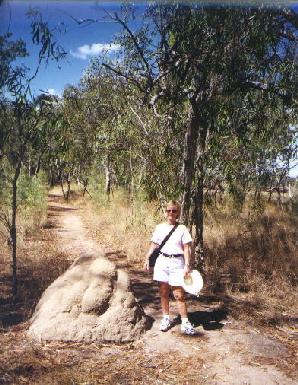
The trees in this area were of average height, plentiful but not too close together. There was grass and some open areas. This is what the Australian bush looks like (similar to the picture above) -- not a thick jungle nor a barren plain.
We reached our accommodation -- a privately owned facility operated in conjunction with the the equivalent of a national park service. A goal was to preserve the environment and fit in nicely (no high buildings, for example); so the owner bought an old set of railroad cars and transported them there by land to use for all the buildings. We slept in converted railroad cars! We dined outdoors under a tent-like cover, though we could also have eaten in original railroad dining cars.
During the day, we toured the lava tubes. There were two tours available: a two-hour tour using stairs to reach the tubes and boardwalks inside, and a 3-1/2 hour tour over rocks. We chose the former to make it easier for Kathy to enjoy the tour, but Michelle (who was not with us for this part of the trip) had previously taken the longer tour and said it was a bit messy! The tubes were fascinating geologically -- about three stories high with ceiling rocks that looked like they should fall in but never did; tree roots snaking their way down into the floor from openings outside; and occasional bats. We also saw rock wallabies on the way in, along with various other wildlife. (On a separate evening tour, we saw the bats pouring out of a tube that is not open to the public.) On the way to the tubes on both trips, we learned about the geology and history of the area from our Savannah guide. Savannah is a name that Australia is trying to apply universally now to identify the outback. To cap off the separate evening tour, we had sparkling Australian wine, fruit, cheese, and crackers atop a rock peak, while observing the sunset (top that, US Park Service!).
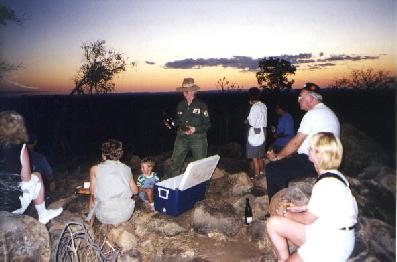
On the morning of the second day we had what they called a bush breakfast. We went to a campfire area and had bacon and eggs, and we toasted bread over the open fire in metal holders. We sat on logs while we ate, and we were urged to shield our plates and keep a close watch, because the birds, particularly the Kookaburra, would swoop down for the bacon! Our hosts were not concerned about losing the bacon; rather, the bacon is bad for the birds.
While we generally stayed at pretty decent hotels throughout our trip, our big splurge was at the Silky Oaks Lodge in Mossman. Silky Oaks is set in tropical woods in the Mossman Gorge, near the Daintree rain forest. There are only 60 units, all separately built chalets (as they call them) on stilts in the woods. Dining is in a covered open-air dining room overlooking the river. You might use the word "exclusive" to describe this place! We stayed there two nights.
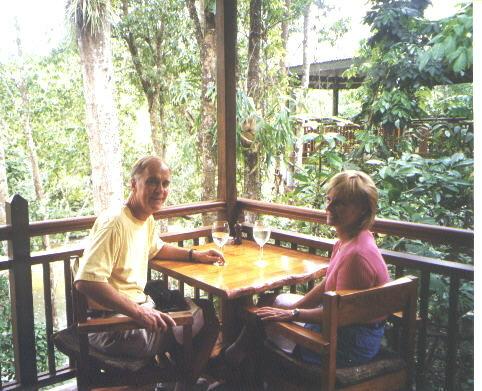
One of the most enjoyable aspects of Silky Oaks was eating in the open air dining room. During the evening, a bandicoot -- an animal that looks like a very small kangaroo or large rat -- roams the dining room looking for scraps on the floor! There is also a wallaby nursery in the center of the property, where we got to hand-feed dad and mom, and observe their joey from a distance, as he was recently out of the pouch. It was interesting to observe mom get out of the way whenever dad wanted to eat something. The kangaroo pecking order is very clear!
The afternoon of our arrival, we took a self-guided tour through the woods (into the Daintree rain forest). It was a bit tough hiking over the rocks at times for Kathy, but we made it to the river and back in an hour or so. (Kathy will tell you we nearly got lost, but don't listen to her....) It was like walking through a jungle -- you wouldn't want to stray off the trail!
On the day in-between, we took a large catamaran (Quicksilver Reef Cruise) from Port Douglas out to the famous Great Barrier Reef. The weather wasn't great on this particular day, but that didn't matter too much, since we were more interested in what was underwater. On the spur of the moment, Fred decided to take advantage of an add-on tour they offered to go scuba diving for the first time -- no experience required! (I'm not sure you can do that in the USA....) It was great. We went down to the bottom of the reef (the snorkelers are limited to the top in a fixed swimming area) with a guide in a group of five. We saw some big fish up close and a ton of smaller, colorful ones, in addition to the marvelous reef life. We were allowed to touch one bizarre underwater organism about 18 inches in diameter to watch/feel it withdraw its tentacles from our hands, while a small yellow fish kept swimming freely among the tentacles on his own. Later, we toured the reef via a sub-like boat with big glass windows. While we enjoyed the trip, we might advise others to seek out a smaller vessel to get a little more one-on-one education and attention.
Returning to Silky Oaks, the morning of our departure day Fred took a guided walking tour of nearby Mossman George park, viewing huge fig trees and their bizarre root structure, giant spiders in their webs, a tree lizard, the scenic rivers flowing through the gorge, etc.
Another of the must-do trips (in addition to the Great Barrier Reef) in this area is Kuranda. It is not the village of Kuranda that is so interesting (Kuranda is a small village of good shops), but how you get there and back! You take an old train up the mountain through very scenic territory. There are a couple of stops for photo-ops along the way. Then you visit Kuranda for an hour and a half. Then you do the most interesting part: you board a skyrail (cable car, maximum of six passengers) for a trip through the mountain area and back down to near where you started. What is especially interesting is that the skyrail takes you over the treetops in tropical forest, all the while with marvelous mountain views around. As you come back down the mountain, you can see all the way to the ocean. There are two stops along the way to get out, tour, and photograph.
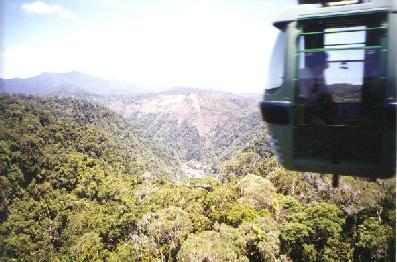
The skyrail ends right next to the Tjapukai Aboriginal Cultural Center, where we spent several hours learning about he Aboriginal culture (at least as it applies to this particular tribe). Fred also learned how to throw a boomerang (they really do come back if thrown correctly!)
We based ourselves in Palm Cove for this trip. It is a small community (no web site), though we were on a huge resort called the Novotel Palm Cove Resort. Most of the other accommodations there are smaller and right across the street from the ocean, while the Novotel is set back a few blocks. There is a Courtyard Marriott at the far end of Palm Cove, too. The main street (essentially the whole town) is just a few blocks long, with a long strip of beach on one side of the road. Like many towns in this area, it is a place to base yourself while you take day trips, but you can always just spend a day on the beach!
Alas, it came time to leave Australia. We got up at the ungodly hour of 3 something to catch a shuttle to the airport for a 6:20 AM departure. We had decided in advance that after two weeks of touring, we needed to relax, not tour, so we planned to spend the last few days of our vacation on the beach in Fiji. Unfortunately, you can't fly directly from Cairns to Fiji, so we had to head south to Sydney, then change planes to get to Fiji. One nice thing about traveling business class is that you can use the Qantas lounge, so we got a bite of breakfast there and relaxed a bit before our flight. Fred was also able to use an internet terminal there to send out a couple of quick messages.
(As an aside, it was interesting to note throughout our trip to Australia the number of "Internet Cafes" -- small shops where you could use an Internet terminal for a per minute or per hour fee. They were always jammed with patrons, mostly young people. Also, before we leave the subject of Australia, do you know what is really interesting? Despite what the tour books say, we never heard an Australian say "G'Day" to us or to any other individual during our entire trip! And we should point out here that we found all the Australians to be very friendly. We felt very comfortable touring Australia -- we were treated well and fairly, and we were particularly impressed with the quality of the tour guides. And since tipping is rarely expected in Australia, you can't say they were treating us well for tips!)